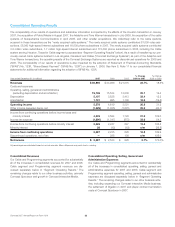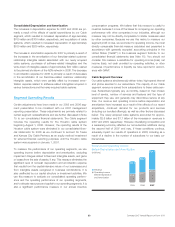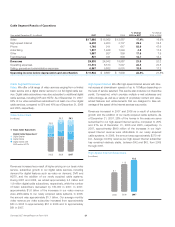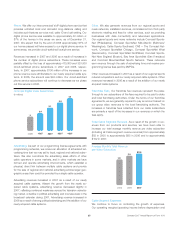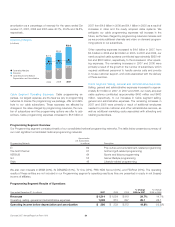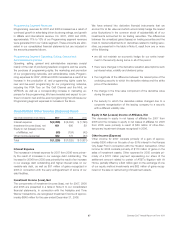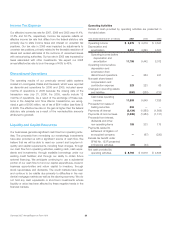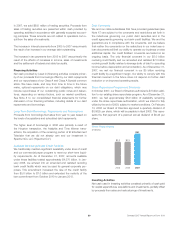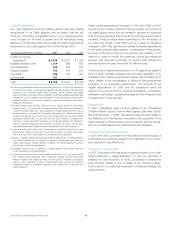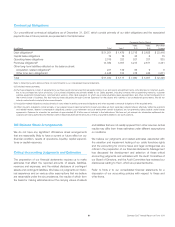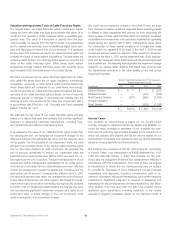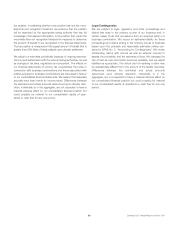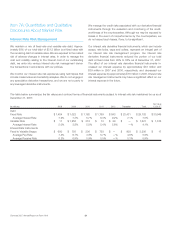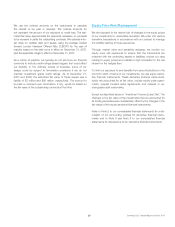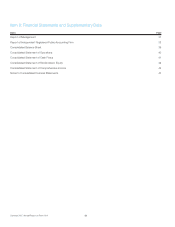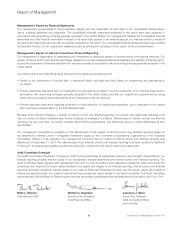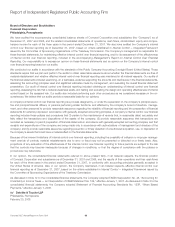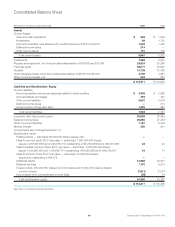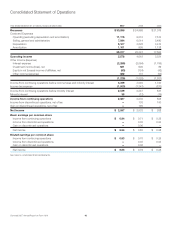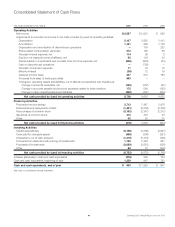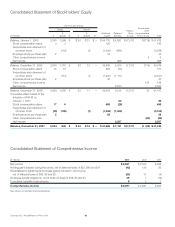Comcast 2007 Annual Report Download - page 34
Download and view the complete annual report
Please find page 34 of the 2007 Comcast annual report below. You can navigate through the pages in the report by either clicking on the pages listed below, or by using the keyword search tool below to find specific information within the annual report.
Valuation and Impairment Tests of Cable Franchise Rights
Our largest asset, our cable franchise rights, results from agree-
ments we have with state and local governments that allow us to
construct and operate a cable business within a specified geo-
graphic area. The value of a franchise is derived from the eco-
nomic benefits we receive from the right to solicit new subscribers
and to market new services, such as additional digital cable serv-
ices and high-speed Internet and phone services, in a particular
service area. The amounts we record for cable franchise rights are
primarily the result of cable system acquisitions. Typically when we
acquire a cable system, the most significant asset we record is the
value of the cable franchise rights. Often these cable system
acquisitions include multiple franchise areas. We currently serve
approximately 6,000 franchise areas in the United States.
We have concluded that our cable franchise rights have an indef-
inite useful life since there are no legal, regulatory, contractual,
competitive, economic or other factors which limit the period over
which these rights will contribute to our cash flows. Accordingly,
we do not amortize our cable franchise rights but assess the carry-
ing value of our cable franchise rights annually, or more frequently
whenever events or changes in circumstances indicate that the
carrying amount may exceed its fair value (the “impairment test”),
in accordance with SFAS No. 142, “Goodwill and Other Intangible
Assets” (“SFAS No. 142”).
We estimate the fair value of our cable franchise rights primarily
based on a discounted cash flow analysis that involves significant
judgment in developing individual assumptions, including long-
term growth rate and discount rate assumptions.
If we determine the value of our cable franchise rights is less than
the carrying amount, we recognize an impairment charge for the
difference between the estimated fair value and the carrying value
of the assets. For the purpose of our impairment tests, we have
grouped the recorded values of our various cable franchise rights
into our five cable divisions or units of account. We evaluate the
unit of account periodically to ensure our impairment tests are
performed at an appropriate level. Before 2007, we used our ca-
ble regions as the unit of account. Frequent reorganizations of our
regions and further management centralization of our cable opera-
tions led us to conclude that our cable divisions are more reflective
of how we manage and operate the assets and, therefore, are the
appropriate unit of account. Consequently, effective April 1, 2007
(our annual impairment test date), we changed the unit of account
to five cable divisions from 29 cable regions. We tested for impair-
ment at the region level before combining our regions into divisions
to confirm that no impairment existed before the change. We have
not recorded any significant impairment charges as a result of our
impairment tests. A future change in the unit of account could
result in recognition of an impairment charge.
We could record impairment charges in the future if there are long-
term changes in market conditions, expected future operating results
or federal or state regulations that prevent us from recovering the
carrying value of these cable franchise rights. For example, increased
competition and a slowdown in the economy impacted our operating
results during the second half of 2007. Assumptions made about
the continuation of these market conditions on a longer-term basis
could impact the valuations to be used in the April 1, 2008 annual
impairment test and result in a reduction of fair values from those de-
termined in the April 1, 2007 annual impairment test. Such assump-
tions and fair values will not be determined until the annual impairment
test is performed. The following table illustrates the impairment charge
related to our various cable divisions that would have occurred had
the hypothetical reductions in fair value existed at our last annual
impairment test date.
Percent Hypothetical Reduction in Fair Value and
Related Impairment Charge
(in millions) 10% 15% 20% 25%
Eastern Division $ — $ — $ — $ (537)
Midwest Division — — (102) (675)
NorthCentral Division —(287) (955) (1,623)
Southern Division — — — —
West Division —— (438) (1,268)
$ — $ (287) $ (1,495) $ (4,103)
Income Taxes
Our provision for income taxes is based on our current period
income, changes in deferred income tax assets and liabilities, in-
come tax rates, changes in estimates of our uncertain tax posi-
tions and tax planning opportunities available in the jurisdictions in
which we operate. We prepare and file tax returns based on our
interpretation of tax laws and regulations, and we record estimates
based on these judgments and interpretations.
We adopted the provisions of FIN 48, “Accounting for Uncertainty
in Income Taxes — an Interpretation of FASB Statement No. 109”
(“FIN 48”) effective January 1, 2007. We evaluate our tax posi-
tions using the recognition threshold and measurement attribute in
accordance with this interpretation. From time to time, we engage
in transactions in which the tax consequences may be subject
to uncertainty. Examples of such transactions include business
acquisitions and disposals, including consideration paid or re-
ceived in connection with such transactions, and certain financing
transactions. Significant judgment is required in assessing and
estimating the tax consequences of these transactions. We deter-
mine whether it is more likely than not that a tax position will be
sustained upon examination, including resolution of any related
appeals or litigation processes, based on the technical merits of
Comcast 2007 Annual Report on Form 10-K 32


